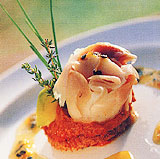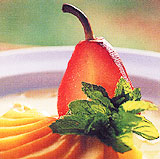|
|
 |
 |
| 18 October 2006 |
|
Menu Planning for Beginners
Our new series on menu planning has just kicked off with the first chapter
explaining the need for a menu in your hospitality business.
What is a menu?
Essentially, a menu is a list of dishes and beverages which has prices attached.
Why do we need a menu?
For the customer:
The menu is an information sheet for the customer. It tells him what is on offer
in the way of food and beverages, at what price in what portion size. It also
creates a "mood" or ambiance and expectations in the mind of the customer.
For the knowledgable manager:
The menu allows the manger to plan his / her whole business.
The menu tells the manger, what type of business he runs.
Read More
|
| Menu
Planning for beginners |
|
 |
 |
| 3 May 2006 |
|
Beginners Guide - Small Kitchen Tools
This is the second installment in the Beginners guide to the kitchen.
In this insallment well be looking at Small kitchen tools.
The trussing needle
This is a needle which is approximately 15 cm long and very sturdy. It
can take a butcher’s twine.
The needle may be straight or bent, like a sail maker’s needle. It is used for
sowing the bally cavity of a chicken or a lamb, veal or pork carcasse closed.
The needle can also be used to pierce the leg joint of a chicken or turkey and
help to truss (shape) the bird by tying the legs and wing joints together and
pushing the breast outwards. This is mostly used in display birds for
showpieces on a cold buffet.
Read More
|
| Beginners
Guide - Small Kitchen Tools |
|
 |
 |
| 3 May 2006 |
Beginners Guide - Pots
In this article in the beginners guide to the kitchen we look at pots in
the kitchen.
GENERAL INFO ON POTS
The material and size of the pot is closely linked to the manner of
heating surface on which it is placed, solid top stoves or individual burners.
The size of the heating surface, determines the bottom area of the pot. Large
pots can be placed on solid top stoves or large individual gas burners, while
smaller size pots are best heated by individual burners or solid top elements.
All pots and pans should be handled carefully, so that they do not fall. This
causes the pot circumference to loose it’s round shape and makes the lid unable
to close tightly. This makes the pot ineffective for it’s purpose, as it looses
too much liquid by evaporation, causing the food to burn easily in the pot.
Never place an empty pot on a hot surface and wait for it to heat up. The heat
will deform and warp the bottom of the pot, making it hollow. This has the
effect,that the surface has no contact with the heating surface and the heat is
not transmitted properly, causing the pot to cook very slowly or not at all.
All pots, kettles and pans, must be stored upside down to avoid dust collecting
inside.
Read More
|
| Beginners
Guide - Pots |
|
 |
 |
| 3 May 2006 |
Beginners Guide - Knives
Below is the first installment of the beginners guide to kitchen tools and
equipment.
In this article we will be discussing all the aspects of Knives, their
different attributes and proper maintenace of your kitchen knife.
THE BEGINNER’S GUIDE TO KITCHEN TOOLS AND EQUIPMENT - Knives
Whether you work in your kitchen at home or in a professional kitchen, you will
have to make use of certain basic kitchen tools and equipment.
By knowing and understanding what each tool has been designed for, how to
identify it, how to handle and store it safely and hygienically, will allow you
to choose wisely for your specific requirements. This should save you money and
injury.
Read More
|
| Beginners
Guide - Knives |
|
 |
 |
| 18 April 2006 |
|
FOLLOW UP ON GM FOODS
During the last instalment, the conclusion was reached that GM foods should be
Attached to a stringent code of labelling, to allow the customer to make an
informed decision.
Each individual new product should undergo strict and long term studies for
after effects and possible harmful consequences.
The following could be taken as a statement of intent.
Objectives of GM foods
Protection of crops against insects and viruses
Increased herbicide tolerance
If possible, to achieve these objectives together with a substantial cost
saving.
Read More
|
| Follow
up on Genetically Modified Foods |
|
 |
 |
| 11 April 2006 |
|
Are genetically modified foods safe?
Introduction
• Genetically modified organism foods (GMO) present us with a problem which is
still not entirely understood by the general population.
• GMO foods are foods whose chromosomes have been mixed with those of other
plants and even entirely other organisms.
• Why do we need GMO foods?
Read More
|
| Are
genetically modified foods safe? |
|
|




